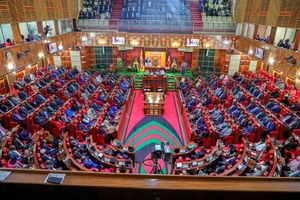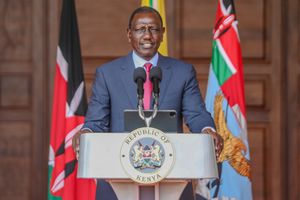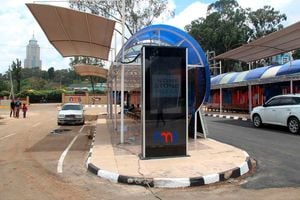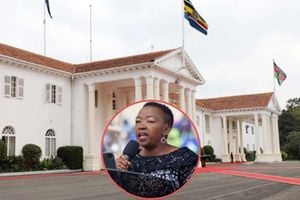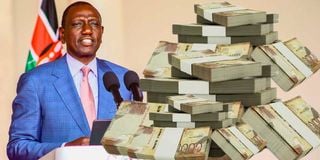
President William Ruto. An analysis of government expenditure reveals at least Sh54 billion wasteful spending.
An analysis of government expenditure reveals at least Sh54 billion wasteful spending, even as President William Ruto directs State agencies to slash huge allocations to hospitality, travel, confidential kitties and overlapping roles.
After the President assumed office in 2022, he set out to restructure State House in line with his campaign promises and introduced two new departments—the Office of the Council of Economic Advisors and the Office of Economic Transformation.
Dr David Ndii was appointed chairperson of the Council of Economic Advisors, while Augustine Cheruiyot was tapped to lead the Office of Economic Transformation.
The two departments, tasked with helping President Ruto bring to reality his Bottom-Up Economic Transformation Agenda have over the years received funding of nearly Sh1 billion despite having nearly similar functions.
In the 2023/24 financial year, Dr Ndii’s team was initially allocated Sh182 million, while Mr Cheruiyot’s office got Sh323 million.
Both departments could now come under scrutiny as President Ruto looks to slash Sh177 billion from his initial budget plan, following nationwide anti-tax protests that have backed the Head of State into a corner in the past month.
State House spokesperson Hussein Mohamed was yet to respond to our queries on the duplication of functions by the two offices by the time of publication.
As the National Treasury and National Assembly rebuild Kenya’s fiscal plans for the 2024/25 financial year, they face the acid test in aligning the new budget with President Ruto’s directive to cut wastage and extravagance.
Extravagance and wastage
Budget books from the 2023/24 financial year point at the extravagance and wastage that played a role in youth-led anti-government protests that have been sustained for over one month.
In the 2023/24 financial year, taxpayers spent at least Sh54 billion to fund eight wastage points that President Ruto has now isolated for massive cuts in the next budget, a Nation review has shown.
President Ruto has targeted hospitality, travel, furniture and vehicle purchases, office renovations, advisors, confidential budgets and government institutions whose functions overlap, for the budget cuts.
In the budget books, the Nation looked at spending on domestic and foreign travel, purchase of vehicles, servicing of vehicles, fuel and lubricants, hospitality supplies and services, office furniture, training expenses and votes listed as “other operating expenses”.
In the 2023/24 financial year, President Ruto’s two workstations—State House and the Executive Office of the President—burned through 1.6 million litres of fuel and lubricants as he and his team traversed the country.
At the same time, the Interior ministry, which includes the National Police Service and local administration, got a Sh179 million allocation specifically for fuel and lubricants.
This means that moving the President and the teams under his offices cost two times that of security agencies, going by the specific allocations.
Purchased fuel
However, the Interior ministry and other institutions could still have purchased fuel under their “other operating expenses” vote head in the budget books.
Deputy President Rigathi Gachagua’s office got a Sh141 million allocation for fuel and lubricants.
The specific allocations to fuel and lubricants in the budget books totalled Sh980 million. The actual spend was higher as several institutions bought the products using their operating expenses budget.
After rejecting the Finance Bill 2024 on account of widespread protests that caught the world’s attention, President Ruto pledged to cut out non-essentials from the rebuilt budget.
In the 2023/24 budget books, the allocations specific to hospitality totalled Sh3.7 billion. The actual figure was, however, higher as some institutions spent on that vote using their allocations for “other operating expenses”.
State House and the Executive Office of the President were allocated Sh1.275 billion for hospitality supplies and services.
But the entire government was allocated Sh6 billion for hospitality. This means that President Ruto’s stations accounted for 21 per cent—nearly a quarter —of the entire government’s luxury spending.
State House was allocated Sh885 million for hospitality supplies and services, while the Executive Office of the President received Sh390 million.
The Prof Kithure Kindiki-led Interior ministry was second in luxury spending with a Sh790 million allocation, while Mr Gachagua’s office was third with Sh394 million.
Fuel and hospitality spending are just the tip of the ice berg, as the National Assembly searches every nook and cranny to abide by President Ruto’s directive on budget cuts.
Specific allocations for servicing vehicles in the books was Sh358.5 million, but many institutions spent more under their operating expenses budget.
Mr Gachagua’s office got the highest allocation for servicing of vehicles at Sh97 million. This was Sh10 million more than the Interior ministry, whose allocation includes servicing of vehicles for police and local administration officers.
Interestingly, despite the Presidential Communication Service (PCS) handling public communications for State House, several departments within the house on the hill still got allocations for purchasing equipment like cameras.
State House Nairobi had the highest allocation with Sh40.8 million. Dr Ndii’s Council of Economic Advisors got a Sh9.4 million allocation, more than the Sh7.2 million that was earmarked for PCS, which is the central communications point at State House.
Former Defence CS Monica Juma, who is now the national security advisor to the President, also got a higher allocation than the PCS, with Sh8.2 million for acquisition of communications equipment and services.
Others that received similar allocations are the Office of the First Lady (Sh2.8 million), Office of Fiscal Affairs and Budget Policy (Sh3 million), Office of the Secretary to the Cabinet (Sh3 million), Office of the Council of the Climate Change Advisor (Sh1 million) and the Policy and Research Analysis department (Sh81,850).
In total, State House was allocated Sh87.5 million for the acquisition of communication equipment and services.

